Walks 24 - 36
The Final Walk for Mums in May 2021
June’s final walk, Walk number 36, in her challenge of completing 21kms in every diocese in Ireland during 2021 took place at Tinahely in south Co Wicklow in the Diocese of Cashel, Ferns and Ossory on Tuesday 26 October - a pleasantly warm and still autumn morning. In thanking the members from that and neighbouring dioceses who had come to see her off on the walk, June said she had been determined to finish the series of walks before winter set in but had not expected to be able to do so without wearing a coat at the end of October.
Ten ladies and two gentlemen tackled some or all of the walk and the scene for the morning was set with prayers by the All-Ireland Treasurer, Rev’d Ken Rue, and a welcome from the CFO Diocesan President Lesley Bayley. Five walkers completed the full distance of 7.5kms - June, Diocesan and AI Trustee Margaret Jacob, Meath and Kildare DP Sylvia Wheatley and her husband Tom and Rev’d Ken – but most of the distance was also covered by local member Hazel Stedman and Sylvia and Tom’s daughter Karen with her two children. Some members from branches throughout CFO diocese completed shorter walks along the same trail.
The main route was along the Railway Walk beginning south of the village of Tinahely; this trail was opened in 2007 and follows the line of the former railway (closed in 1964) for about 2.7kms from Woodenbridge to Shillelagh. In parts it passes through open farmland and runs mostly alongside the River Derry. On this route the walkers passed under two railway bridges, looked across open fields to many grazing cattle but the majority of the pathway was closed in by trees, turning to their glorious autumn colours. The walkers also noticed many strangely coloured fungi attached to the trees and even some holly bushes already resplendent with red berries.
When they reached the end of this part of the walk, the group of five continued into Tomnafinnoge Oak Wood. Here they took one of the designated circular routes – the Hazel Walk – which crossed a bridge over and continued mostly beside the Derry River, much wider and flowing much faster here. It was also a more open walk on wider paths and they climbed up a slight hill and passed a wonderful old oak tree, covered now with many “fairy” doors, obviously a great attraction for children.
Leaving the car park at the entrance to the Tomnafinnoge Wood, the walkers retraced their steps back along the main Railway Walk to where they had originally entered the pathway - they commented on how different it looked as they were walking in the opposite direction. As the group of five emerged from the woods, they were greeted by the other walkers, applauding as June’s “21 in 21” challenge came to a perfect end, outdoors on a glorious autumn day surrounded by MU members.
She thanked them – and the officers from all the other dioceses – for making it possible for her to fulfil this personal walking challenge across the whole island of Ireland and thus, by sponsorship, helping to replenish the “Mums in May” All-Ireland Fund.
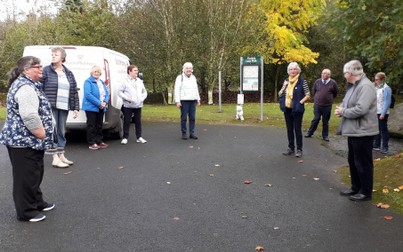
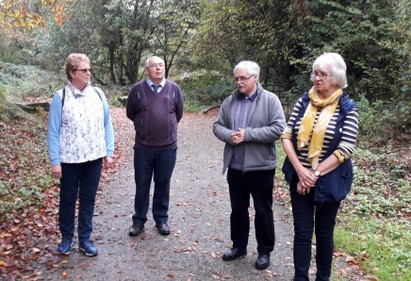
On a glorious Monday morning – the October public holiday in
the Republic of Ireland – twelve MU members and one stalwart husband gathered
at the parish church of St Mary in Blessington, Co Wicklow to join in a short
period of prayer led by the Dublin and Glendalough MU Diocesan Chaplain, Canon
Leonard Ruddock. He is also the rector of the three parishes in the Blessington
Union and he was the perfect guide for the walkers that morning as he holds a
wealth of knowledge about the area. It was June’s final walk in this Diocese,
and her penultimate in the series of MIM walks this year (Walk Number 35).
Nine walkers began the walk from the church up the main road
to join the Blessington Greenway near the Avon Ri activity complex.
Accompanying June and Canon Leonard were the Dublin and Glendalough DP Karen
Nelson (and her lovely little dog, Alfie) Trustee Ada Lawson, Meath and Kildare
DP Sylvia Wheatley and her husband Tom who live just over the diocesan border,
Rev’d Canon John Clarke and his wife Jessica, and local branch member Margaret
Stanley.
The group stopped first to admire the views from the Avon
complex across the Blessington Lakes.
Set in the Wicklow Mountains, the Blessington Lakes cover 5000 acres
water. They were formed 60 years ago by the building of the Poulaphouca Dam to
accommodate a hydroelectric station and several small communities were
submerged including a village called Ballinahown. The Poulaphouca reservoir is
the largest man-made lake in Ireland and is a great base for outdoor activities
and a haven for wildlife, as well as providing about one third of the water for
the greater Dublin area.
Along the Greenway, the walkers commented on the trees
beside the path and across the Lakes, just turning into their glorious golden
hues, glinting in the autumn sun. They also noticed many different species of
birds and saw a heron, some swans and quite a few ducks - and even several
young deer. They walked down to the shore of the Lakes to view the ruins of
Burgage Castle and the community cross which was erected in June 2010 in memory
those who were buried at the lakeshore site until their remains were moved to
the community graveyard in Blessington.
The group – now seven in number – rejoined the footpath
beside the N81 for a short distance before turning left back into the forest at
Burgage Moyle Lane. After covering a further three and a half kms along the
Greeenway, they crossed the Valleymount Road to make their way up the incline
of a side road to the main gate of Russborough House. Here they admired the
views across the 200 acre parkland before arriving in front of the magnificent
House – a fine example of Palladian architecture, designed by Richard Cassels
for the first Earl of Milltown and built between 1741 and 1755. The House and gardens, now owned by the Beit
Foundation, have been open to the public since 1978 and within Russborough
House there is a private collection of European fine and decorative arts,
including furniture, silver, porcelain and paintings.
The walkers, having completed 8.3 kms, decided that it was
time for a well-deserved lunch and they were joined by some of the other
members who had not tackled the full walk but had come to ferry them back to
Blessington. June said that sitting in
the sunshine in the courtyard at Russborough House sharing fellowship was the
perfect end to such a lovely walk and that she would definitely return to take
a tour of the House and to walk through the superb parkland.
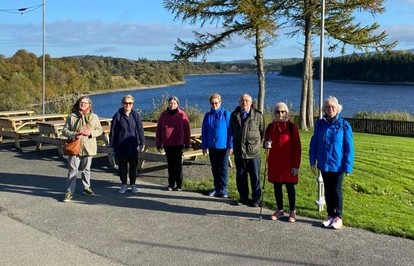
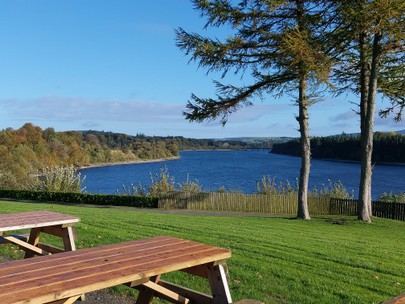
On a beautiful autumnal Saturday 17 ladies and gentlemen met at St Mary’s Parish Church in the centre of Navan for coffee; here they were welcomed by the Diocesan President, Sylvia Wheatley and the Rector, Rev’d Canon John Clarke. They assembled for photographs on the steps of the church before heading off down the main street towards the entrance to the Boyne Walk.
This walk – the 34th in the schedule of June’s 36 walks and the third and final one in Meath and Kildare – was led by Sandra Clarke, the rector’s wife who is also Branch Secretary, and the Navan Branch Leader, Leah Malcolm. Others who were present included several Diocesan Trustees - Olive Potterton F&C, Eileen McKenna Overseas and Ruth Moloney F&P - the Newbridge Branch Leader, the Dean of Trim, the Very Rev’d Paul Bogle, and members from branches within the Diocese, as well as a few husbands and brothers. One of these gentlemen, Geoffrey Clarke, provided a very interesting history of the area as the walk proceeded.
This walk was one of the longest undertaken by June in this challenge – it is a relatively easy walk along a good, flat pathway which continues from Navan as far as Drogheda. The part of the path covered on this 34th walk is linear and known as the Boyne Ramparts Heritage Walk. This 8km stretch goes as far at Stackallen and follows the banks of the River Boyne where the path sits between it and the now derelict Boyne Navigation Canal.
It is also a Special Area of Conservation which aims to protect the nature of the area and the walkers were surrounded by much natural and built heritage along the route. The trees were turning into their autumn russets on both sides of the pathway and the walkers saw many birds and ducks, even passing close to a heron at one point. They walked beside now overgrown canal locks, including Rowley’s Lock, and also Babe's Bridge; this is believed to have been built in the early 12th century and is the only bridge over the River Boyne which survived the great flood of 1330. It then had eleven arches crossing the river from Donaghamore, of which only one survives today.
The walkers passed the ruins of Dunmoe Castle and Ardmulchan Church and made their way as far as the grand Ardmulchan House, close to Taffee’s Lock, and admired its gardens to their right. The group then turned and retraced their steps along over 4kms of the pathway, greeting many Saturday walkers also out for exercise. When they returned to St. Mary’s Church, Canon Clarke led everyone in a short service of thanksgiving, at which June gave a reflection based on Isaiah Ch 43 V 2. A very welcome lunch was served in the Church Room where there was great fellowship, as many of those present had not met for a considerable period of time.
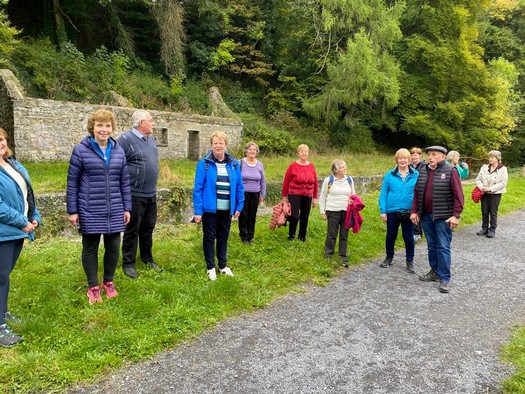
Around 25 people gathered outside St Jude’s Parish Church at
Muckamore, near Antrim, at noon on 13 October to see off the group of walkers
who would accompany June on her 33rd MIM walk - the final one of the
three in Connor Diocese. There was a
great buzz of conversation as everyone took the opportunity to greet those they
had not seen for some time. Special mention must be given to Rev’d John
McClure, rector of the parish, who had been ill for quite some time and Mrs
Paddy Wallace, former All Ireland President of Mothers’ Union.
June thanked everyone for coming, and she made special
mention of the presence of the Bishop of Connor, the Rt Rev’d George Davison,
and the Archdeacon of Connor, The Venerable Stephen McBride. She thanked
everyone for giving of their time - and energy - that day and for their support
for her “21 in 21” challenge and the Mums in May Fund. The Diocesan President,
Sally Cotter, sent the walkers on their way with readings from hymns which
included references to walking, and with prayer.
Irene Gates, the Diocesan Secretary, led this Mid-Connor
walk and the other two walk stewards were members from All Saints MU Branch in
Antrim - Cynthia Cherry and Sheila Thompson. There were 12 walkers in total -
in addition to Bishop George and Archdeacn Stephen, they included several
members from the Diocesan Trustees & Executive Committee - Alberta
Miskimmin, Irene Paget, Geraldine Montgomery, Hilary Boddy and Jean Sheridan,
as well as former DP Valerie Ash.
After walking along the main road downhill from the church,
the walkers crossed to follow the Shakey Bridge River Walk and Mill Race Trail
beside the Six Mile River, crossing several bridges and noting the former mill
wheel, the site of the former mill village and the old railway viaduct. At
these points and several others the group stopped to enable Irene to give
information about the history of the area and particularly the local focus on
the manufacture of linen. They also stopped to admire the several fast-flowing
weirs on the river and its wildlife - they spotted two herons and many other
birds and wildlife on the river banks.
The planned route passed the Antrim Forum and the entrance
to Massereene Golf Club (the clerics locating stray golf balls as they walked!)
before it eventually took them to Antrim Lough Shore Park where Irene gave some
interesting information about Lough Neagh and how it was used for torpedo
testing during World War II. Before leaving the Park, the walkers admired the
newly constructed buildings and the improved marina with its many yachts and
motorboats - and the hundreds of swans and ducks. They then made their way
along the path beside where the Six Mile River enters Lough Neagh, passing the
recently created Massereene Centenary Wood, to the entrance of Antrim Castle
Gardens. While the walkers were tempted to linger in these wonderful gardens,
which were created over 400years ago but completely refurbished in 2011, they
stopped only for a short information session at the derelict castle.
From the Gardens, the group tackled the final stage of the
route, along the boardwalk beside the river, behind the Barbican Gate, to enter
the centre of Antrim town and make their way to All Saints' Church. Here they
were greeted by DP Sally and the branch leader Sylvia Barton and availed of
most welcome refreshments prepared by branch members.
There was then a short service of thanksgiving, led by
Archdeacon Stephen, at which Bishop George gave a reflection based on
Deuteronomy Chap 5 V31-33, aptly focussing on the words “You shall walk
in all the way which the Lord your God has commanded you …..” and
referring to that day’s walk as a mini-pilgrimage. It was a most fitting end to a really
enjoyable day in a new environment for many, good exercise and fellowship,
surrounded by the glories of God’s creation.
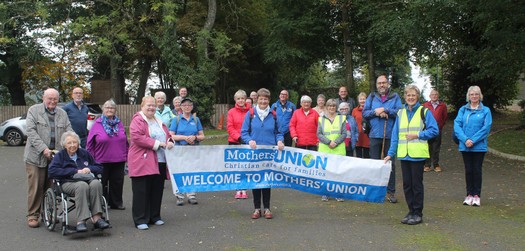
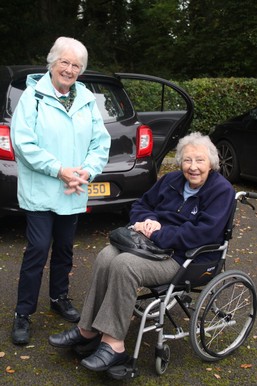
For her 32nd walk, June returned to the Diocese of Armagh, on this occasion to the south of the diocese - Gosford Forest Park. She met with the Diocesan President, Sophia Dillon, in Markethill and drove in the early afternoon to the rectory of the parish of Mullabrack and Kilcluney which lies just outside the town. There the two joined the Rector, Rev’d Dr Peter Munce and the MU Branch leader, Doreen Quinn, and they stood outside in the sunshine, overlooking the Armagh countryside, as Rev’d Peter read from Luke’s Gospel about the meeting on the road to Emmaus and offered prayers for the MIM walk that day. He also apologised for not being about to join the walk due family commitments.
Sophia and June then drove to the nearby Gosford Forest Park, previously Gosford Demesne, which was acquired by the Department of Agriculture in 1958 and comprises some 240 hectares of diverse woodland and open parkland. The Park is also the location of Gosford Castle. In 1986 it was designated the first conservation forest in Northern Ireland and is currently managed by Armagh, Banbridge and Craigavon Borough Council.
The two ladies considered the wide range of walks on offer and decided to tackle first the boundary trail around the Forest Park - it was exactly as described as it took them around the perimeter path, then into the heart of the forest before they arrived back to the car park. It was an undulating hardcore path among such a wide variety of trees, a few of which were beginning to show russet colours. While it was a lovely varied walk, there were few views due to the density of the trees close to the path; the distance covered in around an hour was just over 5kms.
Doreen arrived at that point and Sophia produced a picnic so the three sat at a picnic bench and enjoyed the refreshments in glorious sunshine. To complete the 7km distance, Sophia, Doreen and June chose the castle walk trail which covered just over 2kms and led beside a stream and into a more open aspect of the Park. On this route there were wider and more open pathways through mostly specimen trees which had obviously been planted closer to the Castle, probably at the end of the19th century, in land that had been cleared of the native trees. They passed the huge walled garden, which dates from the early 1800's; the bricks lining the walls are hand-made and came from a brickworks in Newry. The garden was laid out in the shape of a cruciform.
The group walked around the periphery of the castle walls, noting from an elevated viewpoint that most of the outside of the castle itself had been repointed and cleaned. The present Castle was completed around 1850, for the 2nd Earl of Gosford and cost £100,000; it is said to be the largest castle in Ulster. It is built in mock Norman style from Mullaghglass granite obtained from a quarry of the same name near Bessbrook, Newry. It was lived in by the family up until 1921 and was used as a billet for troops during the 2nd World War period when the American troops were stationed there. During this time German prisoners of war were also held in the Castle. In more recent times troops were stationed in the Castle during the troubles which began in the late 1960s and in the 1980s the castle and lawns were sold to a Belfast family. For a short period the castle was used as a hotel and it has recently been converted into privately owned apartments.
Having admired the Castle, the walkers made their way back to the main car park, passing through the area designated for caravans (and now glamping pods!) and along the road beside the huge area of parkland, with deer grazing in the distance. It was a beautiful, warm autumnal day for such a woodland walk – June commented that she had been to the Park before but not for many years and the designated, well signposted walks were a great asset.
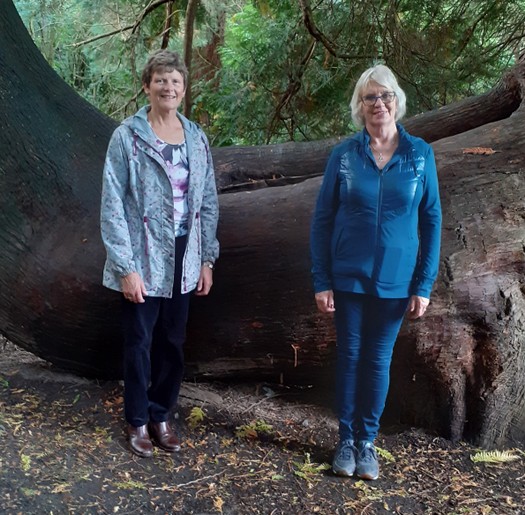
On Saturday 2 October June completed her final walk in Down and Dromore, Walk No. 31 - this time covering almost 9kms! She met with a group of ladies from the Mothers’ Union Branch at Christ Church, Kilkeel, at the church on a glorious autumn afternoon. With the Mourne Mountains as a resplendent backdrop, the branch leader, Jean Keown, welcomed everyone and the rector, Rev’d Alison Calvin, led a short time of prayer. The ladies headed off by car to the nearby Silent Valley Reservoir Park where they were joined by the Diocesan President, Roberta Macartney and her husband Rev’d Gerald, the Diocesan Chaplain, and the Rt Rev’d David McClay, Bishop of Down and Dromore.
The entire area of 9000 acres at the reservoir complex was acquired at the beginning of the 20th century by Belfast City and District Water Commissioners, with the aim of improving the water supply to the expanding city of Belfast. Work began on the reservoir in 1910 but it was not completed until 1933 because of the intervention of World War I. Another phase of the work had been planned to dam the Kilkeel and Annalong Rivers but, instead, a tunnel was driven under Slieve Binnian between 1947 and 1951 to bring water from the Annalong River to the Silent Valley reservoir. Between 1953 and 1957, a second dam was built further up the Kilkeel River valley to create Ben Crom Reservoir. The whole area is now under the control of NI Water.
This walk had been planned and was led by the Rev’d Gerald Macartney. The Bishop prayed with the group of 12 walkers who, in addition to the local MU members, included DP Roberta, Rev’d Ali, and two diocesan trustees - Marion Edwards and Rosie Teggarty. The Bishop joined the group, renewing former acquaintances as in the 1990s he was rector in Kilkeel parish, as they made their way along the first part of the walk; this was on an earth path through the woodlands to the south of the reservoir, across a bridge over the Kilkeel River and then through the woods - with the trees beginning to acquire their glorious autumnal colour - up to a picnic area beside a small lake. The group then continued to the wall at the bottom of the reservoir and along the path beside it to meet, at the valve tower, the main tarmac path which runs from the main car park up to Ben Crom Dam.
At the junction a few of the walkers left the group but nine continued up the incline towards the head of the valley. They stopped for a few minutes at the bridge at the Binnian Tunnel (described above) and marvelled at that feat of engineering. Three others left the group at that point and the remaining six walked for a further 20 minutes towards Ben Crom Dam. At a marker before the steepest incline, they turned and retraced their steps to the base of the Silent Valley reservoir where they descended two sets of steps and walked beside the old Boat House, where the water from the Dam joins the Kilkeel River, past the main treatment plant and back to the car park.
All the walkers agreed that it had been a stunning walk, in unexpected sunshine with the colours across the Mourne Mountains absolutely glorious; the photographs certainly demonstrate that! After verifying that the walk was closer to 9km than 7km, the group returned to the parish hall at Kilkeel for welcome refreshments! June said that this had certainly been the most stunning of her three walks in D and D and she thanked especially her friend Marion Edwards who had accompanied her for the duration of all three of them - from the 1st in March to the 31st in October!
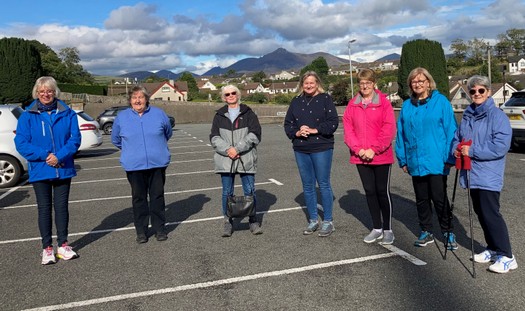

Ben Crom Reservoir
A team of 15 - 14 ladies and one man - the brave rector of
Drumragh parish Omagh, Rev’d Graham Hare - began June’s third 7 km Mums in May
walk in Derry and Raphoe Diocese, walk number 30, in the late afternoon
of 29 September from the parish hall in the centre of the town. The reason it
was taking place at such an unusual time was that afterwards everyone was going
to attend the Derry and Raphoe Festival Service in the lovely old church of the
parish, St Columba’s; this is located - along with four other old churches of different
denominations - in the aptly named Church Street!
This town, riverbank and park walk opened the eyes of all
who were present to the wonderful environment in and around the Omagh. The walk
was planned and led by Kathleen Finlay, the Diocesan Secretary of D and R, and
Iris Moffitt-Scott, the Branch leader of the nearby Edenderry Parish Mothers’
Union. Among the other ladies who walked with June and Rev’d Graham were Jacqui
Armstrong, Diocesan President, Treasurer Kay Stewart, and Diocesan Trustees Ann
Orr and Elsie Stewart. Some of the ladies had travelled from as far as the
Raphoe part of the diocese and from north Co Londonderry.
As the evening traffic began to increase around the town
centre, the group of walkers made their way along Church Street and across
various other streets before descending the steps on to the Oasis Plaza and
crossing the bridge over the River Stroule. They stopped for a few minutes to
look at the plaques on a wall to their left - these are engraved with peace
pledges written by children from 46 local schools.
They also passed the Memorial Garden which commemorates
those who were killed in the Omagh bombing in 1998; here large mirrors are
positioned by computer control and track the sun constantly; when it shines it
pours beams of sunlight on to 31 pole-mounted small mirrors, one for each
fatality. These mirrors are fixed and directed to bounce the light up the
street, around the corner, and via one more mirror mounted high on a nearby
gable, down on to the heart inside the memorial obelisk which the walkers
passed later in the afternoon. It should
then sparkle and glitter gently with the light.
Leaving this part of the town, the group progressed along
the riverside walk passing the confluence of the Strule, Camowen and Drumragh
Rivers, turning left towards the Leisure Centre, the bowling green and the
small Boating Lake - which has never been known to have any boats, just
ducks! They walked further beside the
river into Arleston Park and came to a large weir which formerly fed the various
mills along the river. They stopped for a few minutes to watch a very
industrious heron before moving through a part of the area known as the Lovers’
Retreat - not only is it quite secluded but apparently lovers used to disappear
under its huge weeping willow.
After about 4.5km the walkers moved on to public roads to
make their way back to the centre of Omagh along Hospital Road and Campsie
Road. They all commented that there was much more activity than on the calming
riverside walk. They crossed the Campsie
Bridge on to Market Steet and stopped for a few minutes at the Omagh Memorial.
This glass obelisk was erected in 2008 at the actual site of the explosion - it
is about 4.5m high and is made of solid glass. Near the top, inside, appears to
float a 3-dimensional 'heart' -the immediate image is that of the 'heart'
suspended high in a frozen beam of light.
As they progressed up High Street the walkers passed a
dramatic bronze sculpture called “Balance” and admired in front of the impressive
Courthouse which has stood on that site and dominated the centre of Omagh since
1814; they then passed the Roman Catholic, Presbyterian and Methodist churches
before arriving back at St Columba’s parish hall. There Canon Robert Clarke
joined the walkers and some other Trustees for refreshments and recounted the
historic context and provided stories about the many treasurers of Omagh.
June commented that it had been an exceptionally varied
walk; they had seen many wonderful old buildings in the town and she, like many
of the ladies, had been completely unaware of the beautiful and peaceful
riverside walk so close to the town centre. She also had learned a great deal
about the memorials erected to the memory of those who were killed in August
1998 and planned to revisit them on a day when the sun was shining to
appreciate more fully their impact.
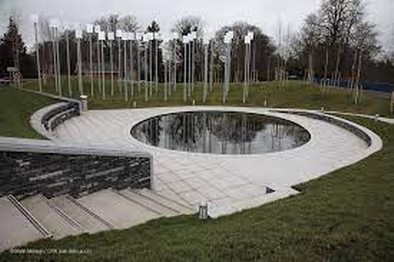
The Memorial Gardens ~ Omagh
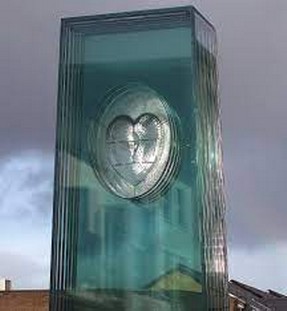
The Glass Obelisk
Fifteen ladies and gentlemen assembled at Skreen Parish Church in Co Sligo for morning prayer, led by the Rev’d Canon Noel Regan. It is a beautiful small church sitting in the countryside and is so much larger than it looks from outside. After assembling for a diocesan photograph on the steps, about ten of those present travelled the short distance by car to Aughris on the coast of Sligo Bay.
Three ladies tackled a shorter walk while seven folk joined June on her final 7km walk, walk number 29, in Tuam Diocese. They were the Diocesan President, Myrtle Nairn and her husband David, the Diocesan Chaplain Canon Jen McWhirter, Canon Noel Regan, Diocesan Trustees Audrey Moore and Sheila Bourke and the Churchwarden of Skreen Parish, Alan Greer.
The walkers left the car park opposite the Beach Bar at Aughris Beach and made their way along the road to join the cliff path, passing first above Aughris Pier to their right. As they climbed the slight gradient to the Head, the views across southern Sligo Bay were good but slightly impaired by cloud. However in the distance they could see the outlines of Knocknarea and Ben Bulben.
As they walked the path – both on grass and hardcore – they observed the very contented cattle grazing beyond the fences and fabulous wild flowers all around, as well as the rock foundations and beaches below them. One of these was Pollaree Beach which traverses an excellent example of an iron age promontory fort. Further along the trail the walkers passed St Patrick’s Holy Well where the local people went to pray in penal times when Catholic worship was prohibited; its waters are said to have healing powers.
After a further kilometre the path turned inland towards a look-out post - one of 83 such structures built along the Irish coast to enable German aeroplanes to be spotted and identified in World War II. Rain had swept in from the Atlantic and the walkers sheltered there for a short time. They then followed the path down to and through the deserted village of Aughris; its decline began with the Great Famine in the mid-19th century when it had a population of over 800 but by the end of the century this number had reduced to 100 inhabitants - the last resident died in 1993. It was a very sad, forlorn sight.
The path from the village was downhill (an interesting experience for all the walkers as the road was slippery and covered with slurry!). It joined the access road which led back to the Beach Bar but as 7kms had not yet been covered in the first hour and a quarter, most of the group headed across Aughris Beach, towards Dunmoran Beach, before retracing their steps across the firm sands; subsequently they again walked along the road to Aughis Pier which was originally a working pier but is now a centre for adventure water sports.
The group decided not to participate in any such activities that afternoon and headed back to the Beach Bar for a very welcome lunch and to meet up with the others who had already completed their shorter walks. Every part of this cliff path walk has spectacular views – from the Ox Mountains on the Mayo/Sligo border to the mountains of South Donegal. June felt it had been one of the most scenic, and dramatic, of her 7km walks.
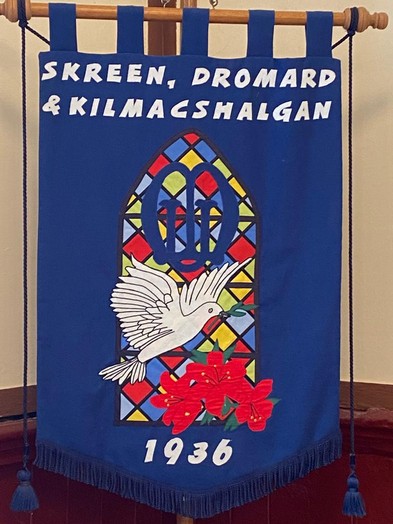
This walk, walk number 28 - June’s final one in Limerick and Killaloe – was organised by the Ballinasloe Branch Leader, Jackie Eastwood and was planned as the “Walk of Seven Churches” as well as a conducted tour of this historic town.
The group of walkers gathered at Ballinasloe Christian Fellowship Church in the centre of the town – this was a converted storehouse which now serves all parts of the community and, in these times, also acts as a food bank. Seven walkers set off - as well as Jackie, June and Diocesan President Lucy Kavanagh, there were the local rector, Rev John Godfrey and his dog, and MU members Jill Cooke, Frances Hurley and Kathleen Newtown.
Leaving the first church, the group headed round the town to the park where the annual horse fair is held each October and overlooking it was the second church - the local Church of Ireland church, St John the Evangelist, situated on Church Hill, one of the highest points in the town. After sheltering under a tree from a heavy shower, they proceeded up the main street passing en route the now abandoned Presbyterian Church – a rather sorry sight. The next church they passed was much more vibrant – the large limestone, St Michael’s Roman Catholic church, situated on St Michael’s Square.
Moving behind the Square, the walkers had to shelter again for a short time from another torrential storm under a tree beside the Ballinasloe Canal. When that lightened they turned right to cross the main the bridge over the River Suck, a tributary of the River Shannon – and for few moments watched a heron fly down the river. They then walked for over a kilometre on Bridge Street and Church Street before turning left into the estate of the former St Brigid’s Hospital - also over time known as Connacht District Lunatic Asylum and St Brigid's Psychiatric Hospital; built in 1833, the hospital which in the 1950s housed over 2000 patients, closed in 2013 and has sat abandoned ever since. In the grounds they passed the fifth and sixth places of worship - two former Roman Catholic churches (both known as St Brigid’s) which were deconsecrated when the hospital closed; both are now boarded up, like most of the buildings in the estate, which is owned by the health authorities.
Having walked around this vast complex, they retraced their steps back to the main town, diverting slightly en route to the seventh church of the walk –– Our Lady of Lourdes, Roman Catholic Church, usually known as Creagh Church as it stands on Creagh Road. Then it was back to the Christian Fellowship Church for a welcome cup of tea and fellowship with the group of walkers and some additional members of local MU branches.
Lucy and June had calculated that they had only completed just over 6kms so after the refreshments they set off to walk to Ballinasloe Marina and then took the path along the bank of the estuary towards the River Suck. Subsequently they returned to where the cars were parked and the trackers showed that the total distance for the day had exceeded the 7kms target by another kilometre! June said that the seven churches was a very different concept for this walk and had been a very interesting way to create a trail around Ballinasloe.
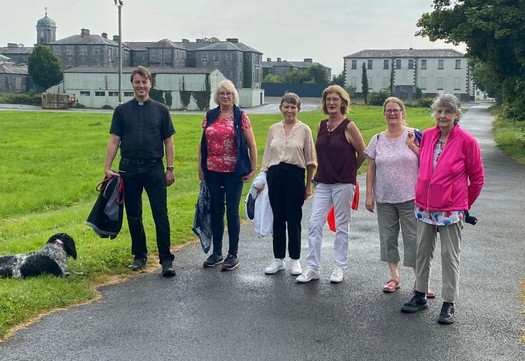
June’s second walk in Limerick and Killaloe, walk number 27, began with over 20 members and friends gathering in the beautiful parish church of St Nicholas, formerly known as the "Black Abbey" - an Augustinian Friary founded in 1316 by the Earl of Kildare, on the outskirts of Adare to have a short service of morning prayer. This had been arranged by the Branch Leader, Jessie Griffin, and it was led by a local lay reader, Dorothy Brislane. Not only were MU members present but there were several ladies from Adare Methodist Church and the local “Active Retired” group as well as visitors from the dioceses of Derry and Raphoe and Cork, Cloyne and Ross.
After gathering outside the porch of the church in the sunshine for photographs, seven walkers headed off on the 7km walk, under the leadership of Rosemary Shier from Adare MU Branch. The other members of this core group were June, the L and K Diocesan President Lucy Kavanagh, Pearl Mitchell, Ann Drew, Mary Dunden and Hazel Sherlock (VP in Cork Diocese). At various points of the day some ladies left the group and others joined.The walkers first made their way along the path beside the River Maigue, a tributary of the Shannon, admiring the wildlife, which included a statuesque heron on the far river bank. They turned left along a path which brought them to the Methodist Church and Embury Close, a beautiful sheltered housing complex which was founded in 1987 by the Methodist and Church of Ireland congregations in the area. They then passed the Village Hall and across a green in front of houses originally owned by the Dunraven Estate.
The group turned left along the Main Street, passing beautiful old thatched and other quaint cottages - most of which had been originally built by the local patrons, the Earls of Dunraven for their estate workers - before turning right into Adare Town Park and making their way to the rear gates of the former manor house. They retraced their steps through the peaceful park to the main thoroughfare, passing the Countess Dunraven Fountain beside the Heritage Centre; this imposing fountain is currently being restored by a heritage grant, having originally been donated to the people of Adare by the Countess Caroline in 1844 to thank them for saving part of the manor house in a fire.
They walked behind the Roman Catholic Church to admire the Dovecoat which interestingly has been converted into a columbarium and then along the main road out of Adare, passing to their right the quainter thatched cottages and the Dunraven Arms Hotel to their left. The imposing gates of Adare Manor, now a hotel, were to their right. When they arrived back at St Nicholas Church they noted that they had only walked 5.5kms!!!! They then drove the short distance to the Woodlands Hotel on the outskirts of Adare where 13 members and friends had a delightful lunch and a great deal of chat and celebration as it was Hazel’s birthday!
To make the full distance of 7kms, five stalwarts – still under Rosemary’s supervision – braved the afternoon heat and walked around the Woodlands estate which is on one side of the grounds of Adare Manor. This is a recently created woodland walk to allow the hotel’s clientele to appreciate better the environment in which the hotel is situated. The walkers passed beside the hotel spa, across Mary’s Garden, through a picnic area and followed the path beside a wood and round a field with grazing cattle. It was the most glorious day without a cloud in the sky – probably the best weather of all June’s walks!
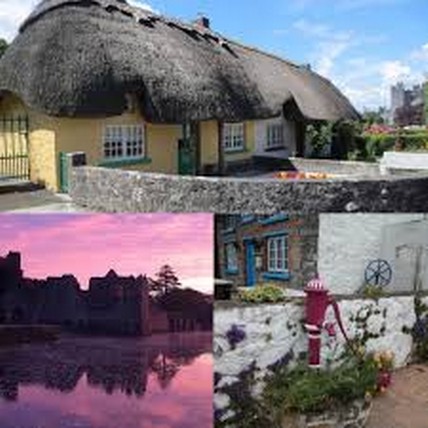
The Village of Adare
June had her first venture into Limerick and Killaloe Diocese on a lovely late summer morning – this was the 26th walk of the series. Diocesan President, Lucy Kavanagh, Margaret Schutz (Diocesan Trustee and Branch leader of Limerick City Branch) and June joined the worshippers for the normal morning prayer service in St Mary’s Cathedral, led by the Dean, the Very Rev Niall Sloane. During the prayers he referred specifically to Mothers’ Union and their work and included the three members present by name and role. They subsequently had a coffee with the Dean at a local restaurant before DP Lucy, MU member Adrienne Baron, also from Limerick City Branch, and June set off on their 7.2km walk.
They headed away from the Cathedral and the centre of Limerick city along the pathway beside the Park Canal. This cycle and walkway, now known as the Rhebogue Neighbourhood Greenway, has been remodelled in recent years and is an excellent resource for the city and especially for students heading towards the university. The group followed it for over 2kms to where the canal joins the River Shannon and the vista to the left widened with views across the river; en route they saw swans, occasional fishing boats and a few fishermen casting off from the banks, much dense and varied riverside foliage, and the derelict Black Bridge.
They ventured beyond the Bridge for a few hundred metres to see the former fishermen’s cottages which have been modernised as holiday homes – usually by those who wish to fish on the river. They then turned inland, to the right, and headed towards the extensive campus of the University of Limerick, much of which they circumnavigated admiring the many modern buildings set in what had been wonderful undulating parkland.
The estate was originally owned by the Maunsell family and the original Plassey House is still an important part of the university. The estate was in the ownership of Thomas Maunsell from 1770 and it is believed that he commemorated his part in the conquest of India (and even his friendship with Clive of India) when he renamed his estate Plassey. The campus lies along both sides of the River Shannon, on a 340-acre site with 110 acres on the north bank and 230 acres on the south bank – no wonder it has been called the most beautiful setting of any university worldwide.
The three ladies completed their walk by traversing the Living Bridge over the River Shannon – this bridge comprises seven 50metre long spans and alternates between rhythms of bridge and island, with lightweight bridge structures joining to more solid pier locations. The architects designed the bridge to move in a beautiful flowing line across the Shannon, mirroring the river and everyone using it has the sense that they are crossing the river on stepping stones. This, now famous bridge, has joined both parts of the campus since early 2010.
To complete the journey, the group walked round the sports centre and out through the main university entrance on to the main road towards Castletroy. June said she had enjoyed the diversity of this walk - the earlier part had been beside the River Shannon and its canals and this had been complemented by walking through woodland to the university campus with all its architecturally diverse and beautiful buildings.
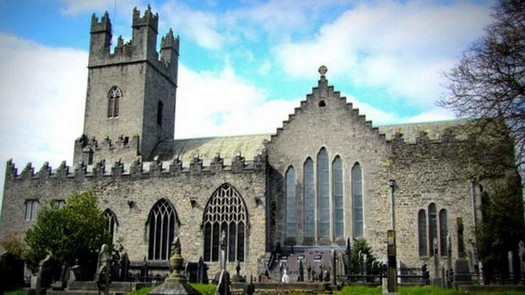
St Mary's Cathedral ~ Limerick
June has now finished two thirds of her walks and, after a short respite, is starting the final dozen. Her 25th walk took place on a dull but dry day in the centre of the Diocese of Meath and Kildare – at the Curragh.
The afternoon began at St Patrick’s Church in Newbridge where the MU Diocesan Chaplain, Rev’d Ruth O’Kelly, led over 20 members in a short service of thanksgiving. Bishop Pat Storey gave a short, very poignant reflection based on Psalm 46 and, after the service concluded, June spoke for a few moments about Mums in May and the commemoration services for the life and witness of Annabella Hayes which had been held in Dublin a fortnight earlier. Present also was the rector, the Very Rev’d Tim Wright and his wife, Karen. Everyone who attended the service took time for tea and fellowship on the steps of the church afterwards, before driving the short distance to the Curragh to begin the walk.
Twelve members and friends started the 7km walk, which covered the undulating grassland close to the famous racecourse – they included DP Sylvia Wheatley, her daughter Karen with her three month old daughter, Tim and Karen Wright, Diocesan Trustee Rosemary Roberts, Tullamore Branch Leader Elizabeth Redding, Rev’d Carol Hennessey, Violet Beattie, Violet Cole, Gwen Cole, Ena Carter and Mary Maher and the Wright and Wheatley canines!
The Curragh is an open plain of almost 5,000 acres of common land close to Newbridge - the area is well known for Irish horse breeding and training and is of particular interest to botanists and ecologists because of the many rare plants and the numerous bird species which nest and visit there. It is composed of a sandy soil and as a result it has excellent drainage characteristics which makes it a popular location for training racehorses.
The group walked in a large oval from where the cars were parked close to the road from Newbridge and south towards the extensive playing fields: from there they walked for a short distance beside a wooded area and further along towards the perimeter of the Curragh Camp which is an army base and military college - the main training centre for the Irish Defence forces and home to 2,000 military personnel.
They then turned right, crossed the main road through the Curragh, walked across the bridge over the busy M7 and headed north towards the formal racecourse area – admiring in the distance the huge newly-constructed stand. A few of the group had to leave for home at that point but the remaining eight followed a slight incline up towards the racecourse, along the only hardcore path they had encountered, and had a “pit stop” for a short time outside the TRI Equestrian Superstore, close to the racecourse entrance. Subsequently it was downhill for the last two and a half kms back to where the cars were parked.
June said this had been a very different walk from the others she had completed – on very open land and not following designated paths. She was surprised not to have seen even one horse (it was the wrong time of the day apparently for them to be out training!) but the group did encounter thousands of sheep – all bedecked in the distinctive colours marked on them by their different owners. None of the sheep seemed in the least perturbed by this group of walkers intruding on their territory.
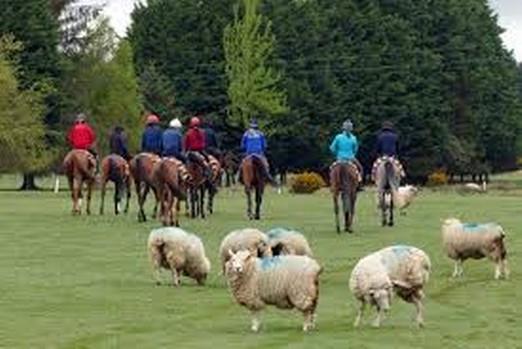
Sheep & Horses on The Curragh
This was June’s 24th walk and planned with the Dublin and Glendalough MU Trustees to be in tandem with the celebrations on 21 August to commemorate the founder of Mothers’ Union in Ireland, Annabella Hayes. The 7.5 Km walk was from All Saint’s Church in Raheny to St Fintan’s Cemetery in Sutton North along the seafront at Raheny looking north east towards Howth Head.
This was a day where the weather threatened a repeat of two weeks earlier when the MU walkers in Phoenix Park had been drenched - storms and heavy rain had also been forecast for the Dublin area on Saturday 21st and those arriving commented on the rain in other parts of the island but this walk was carried out with the occasional shower and certainly no heavy rain - that arrived only at the end of the day’s events.
The walk began with prayers at the parish hall of All Saint’s, led by Rev Ashling Shine, the NSM attached to the parish; she included in her prayers the hope for a dry walk, even with a blink of sunshine! Fourteen members, several husbands, the Diocesan Chaplain Rev’d Leonard Ruddock and his wife Hazel, had gathered at the hall for this quiet time of prayer. Ashling and Karen Nelson (D and G DP) then led the walk from the church grounds. Besides these two ladies and June, those walking included the DPs of KEA, Tuam, Derry and Raphoe and Clogher - Hazel, Myrtle, Jacqui and Irene - as well as David Nairn - Tuam, Barbara Smyth - KEA, and Mary White - D and G. There were ten for most of the walk. Irene left the group as they were leaving Raheny and Sandra Doran (a D and G trustee) joined closer to Sutton
They walked along Howth Road to the centre of Raheny Village where they stopped for photographs at the stone cross in the centre of the village dedicated to Annabella Hayes’ daughter Marie, who died while working in India as a medical missionary in 1908 at the age of 32. They then followed Watermill Road, past one side of the huge St Anne’s Park which stretches from Clontarf to Raheny, to the fabulous Peace Tree (also known at the Tree of Life) situated at a corner of the Park. This has been carved in recent years by Tommy Craggs out of a Monterey cypress that was a landmark of the city but was unfortunately dying. In its 10 meters all kinds of animals and sea creatures feature – they reflect the wildlife of St. Anne’s Park and Bull Island. The walkers had to press on otherwise, as June said, they could have spent all morning gazing at it – the sculpture is so impressive, in size, level of detail and beauty.
The group then turned left past the Causeway Road, which leads out to North Bull Island, to walk along James Larkin Road and the adjacent cycle/ walkway to Sutton. The sea - and the rather misty views over to Bull Island - were to their right. This part of the walk (from the Peace Tree to Sutton Village) was over 4kms in itself.
In the centre of Sutton they walked past the right turn towards Howth and headed up Carrickbrack Road South to St Fintan’s Crescent where St Fintan’s Cemetery was to their right. It is a vast cemetery which has obviously been extended as the old part was distinctly different to the newer part. After greeting the 40 members and friends, Diocesan Chaplains and others who had come from all the Dioceses in Ireland to attend the rededication of the grave of Annabella Hayes, the walkers made their way up the uneven path to the oldest part of the cemetery to join the congregation for the outdoor rededication service led by the Most Rev’d Dr Michael Jackson, Archbishop of Dublin. And it remained dry also for the duration of that very special event!
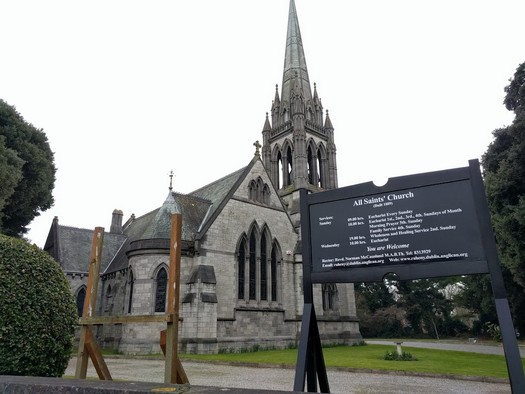
All Saints' Raheny

